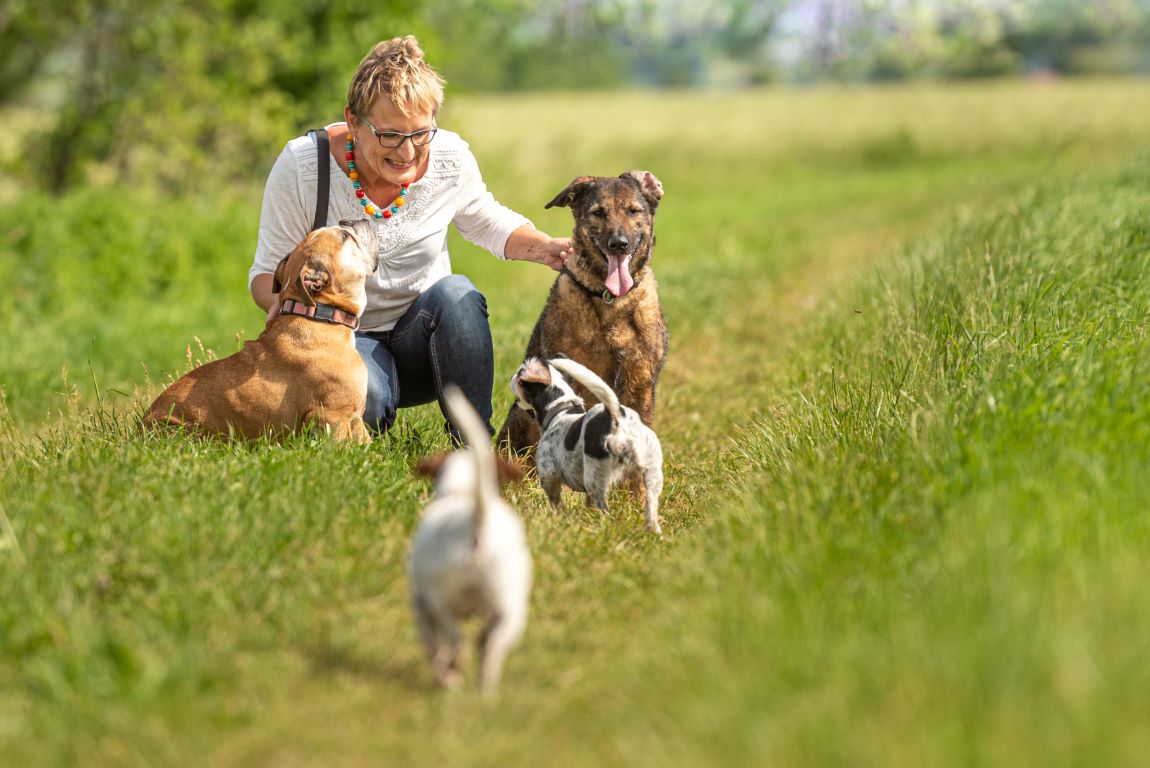
This article explores advanced techniques to enhance your multi-dog walking expertise, ensuring both safety and satisfaction for your canine clients.
Professional Equipment: Investing in Quality Tools
Investing in high-quality equipment is essential. Consider a professional-grade multi-dog lead system, which offers superior control and durability, or a hands-free lead system for maximum efficiency. Opt for ergonomic handles to reduce strain during long walks. Equip yourself with a robust satchel with treats, biodegradable poo bags, and a first-aid kit for any unforeseen circumstances.
How Many Dogs: Striking the Right Balance
When determining group size for walks, professional dog walkers must consider both practical limitations and legal requirements. Most insurance policies for dog walking businesses typically cap coverage at a maximum of six dogs per walker. This aligns with best practices in the industry, as six dogs generally represent the upper limit of what an experienced walker can safely manage whilst maintaining quality care. However, it’s crucial to assess your personal capacity and the individual needs of your canine clients. Factors such as dog size, temperament, and energy levels should influence your decision. For challenging dogs or those requiring extra attention, consider smaller groups of 3-4. Always prioritise safety and quality of care over maximising numbers. Remember, your reputation as a professional hinges on providing excellent service, so it’s advisable to work within your capabilities, even if that means walking fewer dogs.
Training for Group Harmony: Elevating Client Dogs’ Skills
You will often encounter client dogs ill-equipped for group outings. Addressing this challenge head-on adds significant value to your services. Begin with a thorough assessment of each new dog’s leash manners, reactivity, and social skills. Focus on reinforcing basic obedience commands, perfecting loose-lead walking, and gradually improving social interactions. Implement distraction training to build focus amidst the stimuli of group walks. Crucially, involve owners in the process, providing homework and guidelines to ensure consistency. As dogs improve, integrate them gradually into group walks, starting with short, structured outings. This comprehensive approach not only creates more manageable walks but positions you as a premium service provider, setting you apart in the competitive dog care market.
Advanced Training Techniques: Elevating Your Skill Set
To excel in multi-dog management, continually refine your training techniques. Familiarise yourself with various behavioural modification methods, such as clicker training or the ‘Look at That’ game for reactive dogs; see Helpful Links below. Develop a keen understanding of canine body language to anticipate and prevent potential conflicts. Consider pursuing professional certifications to enhance your credibility and expertise.
Positive Reinforcement: The Professional’s Choice
As a leading dog walker, embrace scientifically-proven, force-free methods. Positive reinforcement techniques should be your go-to approach, fostering trust and promoting lasting behavioural changes. Avoid aversive or punishment-based methods, which can increase stress and worsen behavioural issues. Stay updated on the latest canine behaviour research and consistently apply humane, reward-based strategies. This ethical approach enhances the walking experience and cements your reputation as a progressive, responsible professional in the competitive dog care industry.
Hierarchical Walking Strategies: Optimising Group Dynamics
Understanding and implementing effective walking formations is crucial for maintaining control and harmony within your pack. Experiment with different configurations, such as the ‘leader-follower’ method or the ‘surround’ technique for more challenging dogs. Be prepared to adjust your strategy based on the individual temperaments and energy levels of the dogs in your care.
Energy Management: Tailoring Walks to Individual Needs
As a professional, you’ll often be tasked with walking dogs of varying ages, breeds, and fitness levels. Develop strategies to manage different energy levels within the same walk. Consider incorporating short sprints for high-energy dogs, while allowing rest periods for older or less active canines. Master the art of parallel walking, where dogs are exercised side by side at different paces.
Distraction Mitigation: Proactive Risk Management
In urban environments, distractions are inevitable. Hone your ability to anticipate and neutralise potential issues before they escalate. Develop a repertoire of attention-grabbing techniques, such as sudden direction changes or engaging verbal cues. Practice scenario-based training to improve your reaction time and decision-making skills in high-stress situations.
Client-Specific Care: Personalising the Walking Experience
To truly excel as a professional dog walker, tailor your approach to meet the specific needs of each canine client. Keep detailed records of each dog’s preferences, quirks, and training progress. Implement customised walking plans that align with the owner’s goals and the dog’s individual needs. This level of personalised care can significantly enhance client satisfaction and retention.
Post-Walk Protocol: Professional Reporting and Care
Establish a comprehensive post-walk routine that goes beyond basic needs. Perform a quick health check on each dog, noting any changes in behaviour or physical condition. Provide detailed reports to owners, including information about the walk, the dog’s behaviour, and any notable incidents. Consider offering additional services such as basic grooming or administering medications as prescribed by veterinarians.
Continuous Professional Development: Staying Ahead of the Curve
The field of dog behaviour and training is constantly evolving. Stay abreast of the latest research and techniques by attending workshops, webinars, and industry conferences. Network with fellow professionals to exchange ideas and experiences. For example, start or join a private Facebook group with other professional dog walkers in your locality. Consider specialising in niche areas, such as working with senior dogs or managing dogs with specific behavioural issues, to differentiate your services.
Conclusion
By implementing these advanced strategies, you’ll not only improve your multi-dog walking skills but also elevate your professional standing in the dog walking industry. Remember, each walk is an opportunity to refine your techniques and build stronger relationships with your canine clients. With dedication and expertise, you’ll soon find yourself at the forefront of professional dog walking services.
Helpful Links
The ‘Look At That’ Game by Leslie McDevitt
https://www.youtube.com/watch?v=cW_WLETEmNM
How to clicker train your dog
https://www.youtube.com/watch?v=EVIzKL7RauQ



